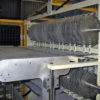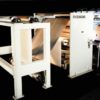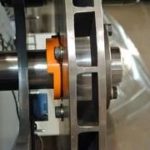Well run sheeter operations require about 1 – 2 minutes to change a roll for shaftless roll stands and 5 – 8 minutes to change a shafted roll when using air shafts. To minimize roll change time:
- While the current roll is being sheeted, prepare the next roll to be loaded
- Strip the wrapper and headers from the roll
- Inspect the roll for edge damage, addressing as required
- For shaftless roll stands, positon the rolls off line, ready for loading
- For shafted roll stands , using a second set of shafts, pre shaft the rolls
- Stop the sheeter before the tail end of the roll is pulled off the core.
- This allows easily splicing the start of a new roll to the tail of the last roll, avoiding rethreading the sheeter at the decurler, slitters, delivery and stacker
- A flapping tail at the end of the run can cause a jam up in the sheeter or misalign up stream settings
- Remove the expired core
- For shafted roll stands:
- First, use material handling equipment (hoists, fork lifts) safely
- Cut end of web from core, leaving webs threaded into sheeter
- If using chucks, remove non-brake side chuck and slide off core
- Better, consider using air shafts instead of chucks
- For shaftless roll stands:
- Cut end of web from core, leaving webs threaded into sheeter
- Open arms of roll stand and remove core
- Load the new roll
- For shafted roll stands:
- Load the new roll
- For shafted roll stands:
- Chuck roll tightly against the chuck left on the brake side of the shaft,
- Insures that the far side of the roll is always in the same place
- Keeping the drive side common, reduces set up time in half
- Carefully load shafted rolls
- Splice the leading edge of the new roll to the tail of the web in the sheeter
- Chuck roll tightly against the chuck left on the brake side of the shaft,
- For shaftless roll stands, regardless of the width:
- Position roll between arms and chuck up roll on floor
- Slightly raise the roll and position behind sheeter
- Add scales or markings on the floor at the unwind location
- Use this aid to position the rolls quickly for alignment
- Splice the leading edge of the new roll to the tail of the web in the sheeter
- For shafted roll stands:
- Thread the web through the sheeter
- Slowly jog the web into the sheeter, taking care not to break the splice
- Insure that the splice is removed in the delivery system, so as not to be stacked in the pile
- Once the new web is fed through the sheeter, run at minimum speed
- Make final adjustments to align the webs to the previous width set up






